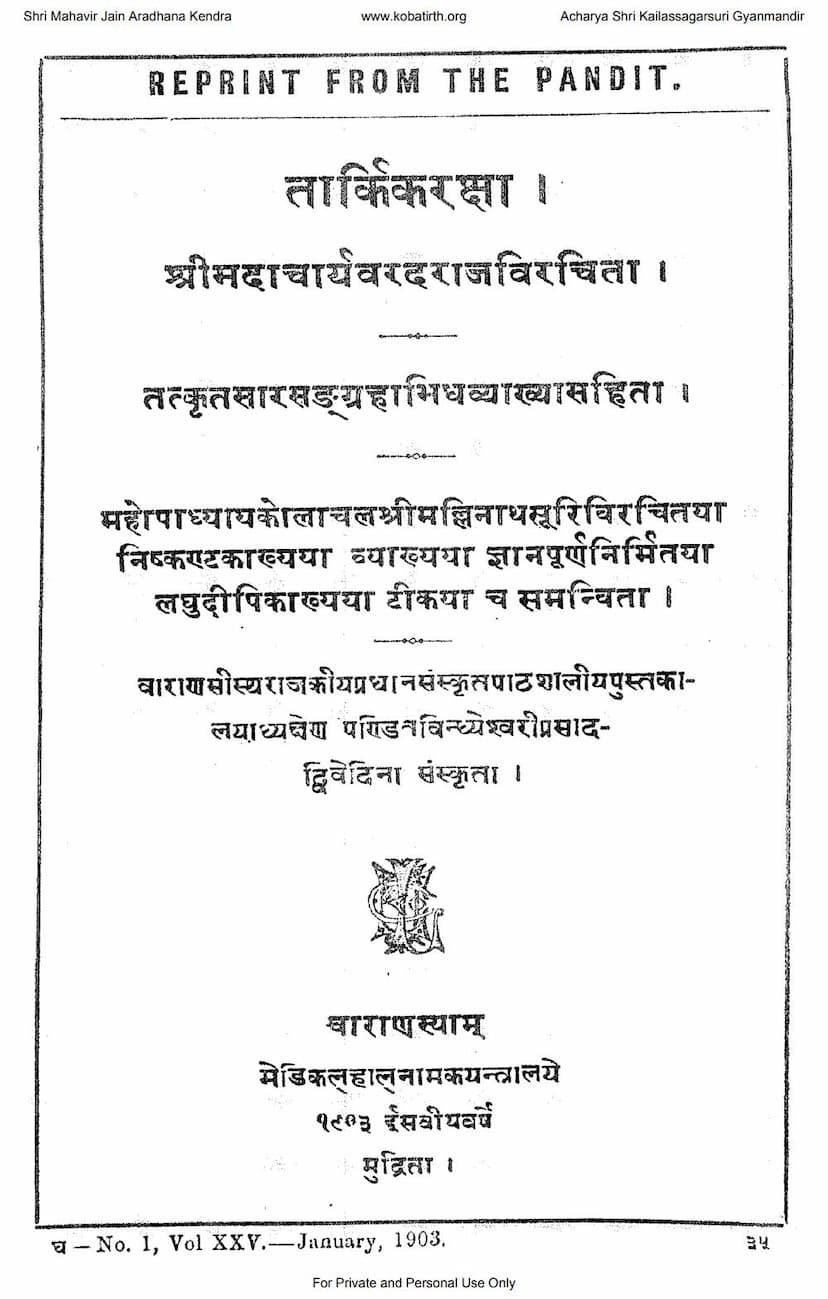Tarkikraksha
Added to library: September 2, 2025

Summary
This is a comprehensive summary of the Jain text "Tarkikraksha" by Varadraj Acharya, with its commentaries by Vindheshwar Prasad, Kolachala Mallinath Suri, and Jnanapurna.
Book Title: Tarkikraksha (तार्किकरक्षा) Author: Varadraj Acharya (वरदराज आचार्य) Publisher: Varanasi (वाराणसी) Commentaries:
- Nishkantaka (निष्काण्टक) by Kolachala Mallinath Suri (कोलाचल श्री मलिनाथ रि)
- Laghu Deepika (लघुदीपिका) by Jnanapurna (ज्ञानपूर्ण)
- Sarasangraha (सारसङ्ग्रह) by Varadraj Acharya himself (implicitly mentioned as being elaborated by Mallinatha's commentary).
- Included is the commentary by Vindheshwar Prasad Dwivedi (विन्ध्येश्वरी प्रसाद द्विविदिना).
Overview:
"Tarkikraksha" (The Defense of Logic) is a foundational text in Jain logic and epistemology. It systematically outlines the core tenets of Jain philosophy, particularly focusing on the means of valid knowledge (pramanas) and the nature of reality. The text aims to defend Jain philosophical positions against opposing viewpoints, especially those from Brahmanical schools of thought like Nyaya and Vaisheshika.
The provided material primarily consists of the introductory and explanatory sections (Bhumika/Prefatory Notice) of this text, including detailed discussions about the authors, their philosophical lineage, and the historical context of the work. It also includes the beginning of the first chapter, dealing with "Pramana" (Means of Knowledge).
Key Aspects and Content:
-
Author and His Times:
- Varadaraja: The preface discusses the likely time period of Varadaraja. He is believed to have lived after Vacaspatimishra (976 AD) and Udayanacharya (fl. around 984-1050 AD), as he refers to them. He predates Madhvacharya, who mentions the Tarkikraksha in the Sarvadarshana Sangraha. A plausible estimate places Varadaraja in the first half of the 12th century AD.
- Jnanapurna: The author of Laghu Deepika, a commentary on Tarkikraksha. His work, dated to Samvat 1459 (1402 AD), indicates a later period. He mentions Vishnu Swamin as his guru.
- Kolachala Mallinatha Suri: The commentator of Nishkantaka. The preface includes extensive discussion about the various Mallinathas throughout history to identify the specific commentator of this work. The preface suggests that this Mallinatha lived around the time of the inscription dating from Vikram Samvat 1580 (1523 AD) or the Shak year 1268, and that he was the son of Narahari and grandson of Mallinatha. This Mallinatha is also known for his commentaries on classical Sanskrit literature like Raghuvansha and Naishadha Charita.
- Vindheshwar Prasad Dwivedi: The editor and publisher, who also provides commentary and context.
-
Structure of Tarkikraksha:
- The text is divided into three chapters:
- First Chapter: Deals with "Pramana" (means of valid knowledge) and related topics like "Chala" (deception/fallacy).
- Second Chapter: Focuses on "Jati" (universal categories) and their analysis.
- Third Chapter: Covers "Nigrahasthana" (grounds for refutation or logical defeat in debate).
- The text aims to present a simple and clear explanation of concepts found in more elaborate works like the Nyaya Sutras and Prashastapada Bhashya.
- The text is divided into three chapters:
-
Core Philosophical Concepts (as indicated in the first chapter):
- Pramana (Means of Valid Knowledge): The text begins by defining and discussing the nature of valid knowledge. It highlights the importance of pramanas for achieving liberation (Nihshreyasa).
- Pramana: Defined as accurate cognition that is not dependent on other means of knowledge. It is characterized by accuracy (yathartha). The text clarifies the definition of prama and pramana, distinguishing them from memory and erroneous cognitions.
- Types of Pramanas: While the preface mentions the Jain perspective, the initial chapters delve into the commonly accepted pramanas in Indian philosophy:
- Pratyaksha (Perception): Discussed in detail, with attempts to define it and differentiate between savikalpaka (determinate perception) and nirvikalpaka (indeterminate perception).
- Anumana (Inference): The text outlines the structure of inference, including the linga (sign), its qualities (roopa), and the importance of vyapti (concomitance). It categorizes inference into anvayi (affirmative), vyatireki (negative), and anvayavyatireki (both affirmative and negative).
- Upamana (Analogy): Explained as a means of knowledge derived from comparing known and unknown entities based on similarity or dissimilarity, often introduced by analogies in language.
- Shabda (Testimony): Discussed as valid testimony, primarily that of an apta (trustworthy person), and its role in conveying knowledge not obtainable through other means.
- Other Categories (mentioned for completeness): The text also touches upon other philosophical categories like Dravya (Substance), Guna (Quality), Karma (Action), Jati (Universal), Vishesha (Specific Difference), and Samavaya (Inherence), as understood within the Nyaya-Vaisheshika framework.
- Critique of Other Systems: The preface indicates that Varadaraja's work engages with and refutes the logical arguments of other philosophical schools (like Buddhism and Mimamsa) on various points.
-
Commentaries and Editing:
- The work is presented with multiple layers of commentary, reflecting a scholarly tradition of elaborating and defending philosophical texts.
- The editorial notes by Vindheshwar Prasad Dwivedi are crucial for understanding the manuscript sources, textual variations, and the historical context. He acknowledges the difficulty in ensuring the purity of the text due to the damaged state of manuscripts.
Significance:
The "Tarkikraksha" is a significant work for understanding the systematic development of Indian logic. It provides a concise yet thorough exposition of logical principles, making it accessible to students. The detailed commentaries by Mallinatha and Jnanapurna further illuminate the complex philosophical arguments and provide historical context for the evolution of these ideas. The text's engagement with other philosophical schools highlights the intellectual vibrancy of the period and the importance of logical debate in establishing philosophical doctrines.
Jain Context:
While the text itself is foundational to Indian logic broadly and likely presents the Nyaya-Vaisheshika framework, its publication and commentary by Jain scholars (as indicated by the "Shri Mahavir Jain Aradhana Kendra" on the pages) suggest a Jain appreciation and study of this important work on logic, perhaps for understanding opposing arguments or for its own logical rigor which can be applied to Jain doctrines. The title itself, "Tarkikraksha," implies a "protection of logic," which could be interpreted as defending logical principles in general, or specifically those relevant to Jainism. The introductory pages specifically mention the "Shri Mahavir Jain Aradhana Kendra," indicating a Jain institutional context for this particular edition and study.